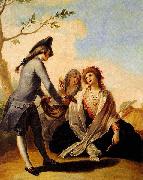Wholesale Oil Painting No Minimum |
|||||||||||
|
|
|||||||||||

|
|||||||||||
|
|
|
||||||||
Ramon Bayeu1746-1793 Spanish Ramon Bayeu Gallery The biography of Jose del Castillo (Madrid, 14.10.1737-Madrid, 5.10.1793) shows that the artist, being in his youth one of the most appropriate painters for becoming a leader of the artistic movement of the Illustrious Absolutism, ends up performing secondary work, paintings for tapestry and some religious works of art, which was not the field where he could best display his talent. Jose del Castillo is a perfect example of how an unhappy destiny can influence on the professional life of a painter under the regime of that time. Surely the unhappy destiny, in point of fact, does not explain anything and we will have to find out the real reasons why one of the most promising careers in painting of the eighteenth century in Spain was crushed. Probably it was a combination of two unsuccessful elections, from our point of view, that excluded the figure of Jose del Castillo from the elite group of artists of that time. |
||||||||
|
|
||||||||
Obsequio campestre
Obsequio campestre Painting ID:: 73669 |
before 1793(1793)
Oil on canvas
183 X 146 cm (72.05 X 57.48 in)
cjr before 1793(1793) Oil on canvas 183 X 146 cm (72.05 X 57.48 in) cjr |
|||||||
|
|
||||||||
|
Francisco Bayeu y Subias Spanish Painter, 1734-1795,was a Spanish painter, active in a Neoclassic style, whose main subjects were religious and historical themes. Born in Zaragoza, he received a broad childhood education. His initial art studies were with a local master, Jose Luzan[1] and Antonio Gonzalez Velazquez. He then moved to Madrid, winning a scholarship with the painting of the ????Tyranny of Gerion???? to study in the Academia Real de Bellas Artes de San Fernando. The death of his parents and the care of his brothers forced him to return to Zaragoza, until he was recalled by Anton Raphael Mengs to help decorate the Royal Palace of Madrid. In later years, one of his colleagues was Francisco Goya, who married his sister, Josefa Bayeu. He served as court painter to King Charles III of Spain. He was named a professor of the Royal Academy of Fine Arts of San Fernando in 1765 and director in 1788. He painted in the Charterhouse of Aula Dei in Zaragoza. In 1767 he was named court painter for Charles III, king of Spain. He was involved in the decoration of various Royal palaces near Madrid. Obsequio campestre Date before 1793(1793) Medium Oil on canvas Dimensions 183 X 146 cm (72 X 57.5 in) cyf |
||||||||
|
|
||||||||
|
Prev Next
|
||||||||
|
|
||||||||
|
Related Paintings to Francisco Bayeu y Subias :. |
||||||||
|
|
||||||||
|
CONTACT US |

